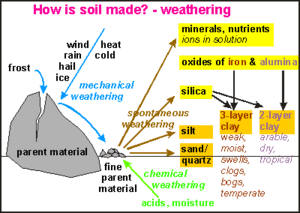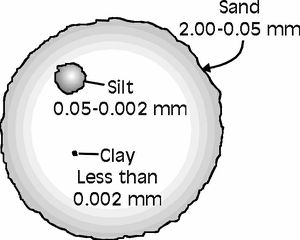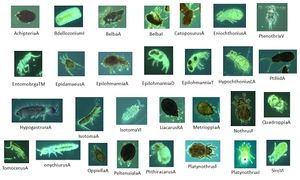Clay
Origins of Clay

Clay is formed from the erosion of a limited variety of environments. Some of these environments include:
1. Continental, which is the weathering and erosion on Earth's surface 2. Marine, which occurs on the floor of a body of water or within the Earth when it is near a heat source.
On the surface of the Earth, erosion by rain, wind, or animals leads to the continuous breakdown of particles. Most often, clays are formed due to chemical weathering, by low concentration carbonic acids or other solvents. These solvents leach through parent rock material and chemically break them down. Eventually, enough weathering occurs to form clays, which are less than .002mm in diameter. Some clays may form due to hydrothermal activity, where hot water circulates material over enough time to break them down to fine grained particles.
Characteristics of Clay

Clays can be found in a multitude of colors based on the minerals present, including red, brown and light colored clays.
In order to be classified as a clay, the particles must meet certain criteria. The grain size must be less than .002mm, resulting in a very high surface area. Clays have the ability to bond with water from the soil due to their molecular structures. Clays are made up of various minerals which are classified as hydrous aluminum phyllosilicates. These minerals may be iron, alkali metals, alkaline earths or other cations that may be found in the surrounding soil. The basic structure of the phyllosilicates is based on interconnected six member rings of SiO4-4 tetrahedra that extend outward in infinite sheets. Phyllosilicates may contain additional molecules such as hydroxyl ions and cations. This results in two basic groups of sheet silicates:
1. The trioctahedral sheet silicates where each O or OH ion is surrounded by 3 divalent cations, like Mg+2 or Fe+2.
2. The dioctahedral sheet silicates where each O or OH ion is surrounded by 2 trivalent cations, usually Al+3.
These molecular structures and build upon themselves, resulting in sheet minerals such as talcs and micas. These minerals can be found in parent rocks and serve as the structural basis of clays, which allow them the ability to bond with water. However, in addition to these essential minerals which allow water to bond, clays can be made up of metal oxides, quartz, and organic material. These characteristic are essential to plant and animal life in soils, and these porous spaces between clay grains facilitate the creation of microhabitats and communities that contribute to the complexity and heterogeneity of soil.
Residual Clay
Residual clay is clay that has not been transported away from the parent rock. This type of clay is most often formed from weathering on the earths surface, which can happen in a few different ways. One way is that it can have chemical deposition of rocks, like granite. Another is, solutions of rocks like limestone have impurities but can be deposited as clay. Once this happens residual clay is formed and can then be harvested for different uses. Residual clay is considered to have low plasticity and will not stick together very easily which, limits its uses.
Sedimentary Clay
Sedimentary clay are minerals that broke down from the original parent material, through weathering and erosion. They are then transported by wind, water, ice, or any other mode of transport away from the parent rock. As these particles are being transported the are suspended in the water because they are so small. They will only be deposited when the clay particles bump into each other causing them to stick together and sink down to the bottom of the river. When they get moved there are eroded further causing them to decrease in there size. This type of clay is considered to have more plasticity this means it will form a sticker soil.
Organisms That Live in Clay

Clay is not very suitable for many plants to live in, as air has a hard time getting through the soil to the roots because the soil is packed so tightly. There is also a drainage problem with clay dominate soils. Some plants that can tolerate this conditions are coniferous trees such as; pine trees, spruce, balsam fir, and tamarack trees to name a few. Some deciduous trees also can grow in clay dominate soils like; willows, crabapple trees, and some maples. There are also some organisms that live within the predominantly clay soil as well. From, macro-fauna like earthworms and insects to micro-fauna like bacteria, nematodes, and other microscopic organisms can live within clay soil. In order for most things to grow in clay soil you would need to till in peat moss into the soil. Peat moss will increase the carbon content in the soil and help plants to be able to grow much better.

References
"Clay Types, Geology, Properties and Color Chart (GcCeramics) - Meeneecat." Google Sites. N.p., n.d. Web. 14 Apr. 2018.
"Earth Sciences: London's Geology." Clays and Clay Minerals. N.p., n.d. Web. 14 Apr. 2018.
"How Is Clay Formed? Is It Inorganic or Organic?" The Clay Ground Collective. N.p., n.d. Web. 14 Apr. 2018.
"Trees and Shrubs for Clay Soil." Trees and Shrubs for Clay Soil : UMN Extension. N.p., n.d. Web. 14 Apr. 2018.
Environmental Characteristics of Clays and Clay Mineral Deposits. N.p., n.d. Web. 14 Apr. 2018.
Kodama, Hideomi, and Ralph E. Grim. "Clay Mineral." Encyclopædia Britannica. Encyclopædia Britannica, Inc., 20 Feb. 2014. Web. 14 Apr. 2018.